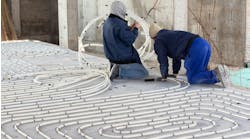Latest from Radiant
eBook: Nelson Mechanical Stories - Volume 1
Sponsored
WE DISCUSSED THE potential of solar thermal energy as an alternative to conventionally powered snow-melt systems in last month's column (pg. 24). This month, we will begin to look at Mother Earth as an energy alternative.
It's funny how at times we think we have a really great idea, only to discover that many other people have had the same idea and have, in fact, put it to practical use. I had a similar incident with the last series of columns on snow-melt systems.
I had a customer on a large lot who wanted to install a snow-melt system for the north-facing side of his home, but he didn't want to install energy-intensive boilers and associated equipment to make it work. He was thinking more in line with solar. I sat there, looking at all this land he owned, and I was thinking earth-linked, with possible solar augmentation.
He said right upfront that he didn't expect perfectly dry pavement at all times. He really didn't mind getting out there with his small lawn tractor to push snow off the surface. It was, however, his experience that without heat, permanent ice would set in and would remain there until the spring thaw. Basically, he wanted to make sure he could break the ice free from its death grip on theconcrete without having to resort to chipping away at the surface and damaging the concrete as he'd had to do for years on a commercial property he owned in town.
Excellent idea, I thought to myself. An earth-linked snow-melt system with the possibility of being able to "idle" the slab without using a significant amount of fossil fuels. So I began my search for the ultimate low-energy heat source for snow-melt systems.
I had heard from different sources over the years about systems that were earth-linked that worked fairly well. Given a little extra time, little or no labor would be required to maintain a safe concrete surface.
So, I began my research, armed only with a Google search engine. What I found was quite interesting. It seems that earth-linked systems have been around and successful for quite some time.
Earliest known mechanical systems dated back as far as 1948 to a system that was installed in Klamath Falls, Ore. The system involved drilling a well down into a shallow layer of rock that was heated by a geothermal spring and placing a tubular heat exchanger down the hole to isolate the glycol from the spring water. The snow-melt system was used for a slick traffic intersection on an 8% slope. It worked well for many years, but due to external corrosion it eventually failed and it was replaced recently with PEX tubing. The system partially exhausted the heat from the geothermal spring, and the drilling of additional wells was required to boost the operating temperatures.
This was a wonderful thing, but it wasn't quite the focus of my investigation. Unfortunately, molten lava doesn't reside close to the surface for most of the geographical coverage of these United States, so I continued my journey. Kudos to the traffic engineers, though, for coming up with a great mechanical resource to cure a nagging traffic problem.
My next excursion brought me to a true earth heat-only system, what I would consider a "low-grade" heat source that was used in New Jersey back in 1969. The installers buried pipe at depths of between 3 ft. and 13 ft. deep on 2-ft. centers and at a ratio of 2:1 of earth to melted surface ratio, and they installed a small circulator to move the energy from the earth to the snow-melt surface; the system performed beautifully.
You must understand, that the snow that falls in New Jersey differs significantly from the snow that falls on Aspen, Colo., as do the prevailing weather conditions in both locations but, nonetheless, it worked like a champ. The system was capable of maintaining a safe surface with a snowfall rate of between 1⁄4 in. and 1⁄2 in. of snow per hour with a corresponding air temperature between 20°F and 35°F. Perfect for the shores of Jersey.
This system proved superior to a companion electrical system sized at 68 Btuh/sq. ft., using only 2% of the electrical consumed by the companion electrically heated system for the same comparable surface results. Now that is a significant reduction in energy consumption!
Tune in next month as we continue our search for the ultimate energy-free snow-melt system. Until then, Happy New Year Hydronicing!
Mark Eatherton can be reached via e-mail at [email protected] or by phone at 303/778-7772.
Mark Eatherton
Mark Eatherton material on this website is protected by Copyright 2017. Any reuse of this material (print or electronic) must first have the expressed written permission of Mark Eatherton and CONTRACTOR Magazine.

